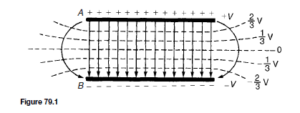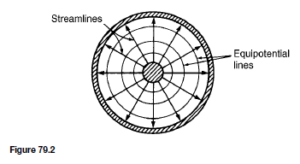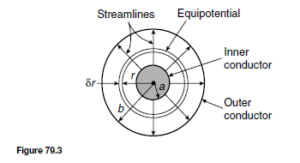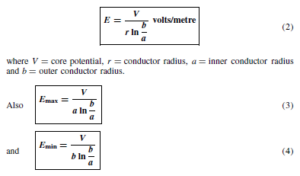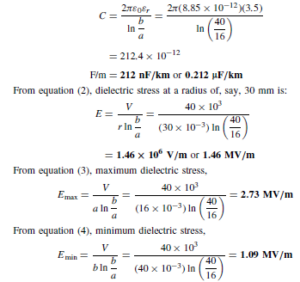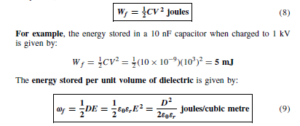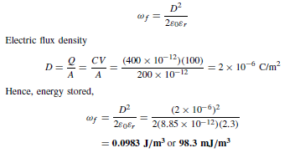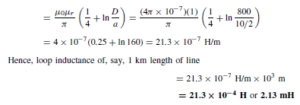Introduction
Electric fields, magnetic fields and conduction fields (i.e. a region in which an electric current flows) are analogous, i.e. they all exhibit similar characteristics. Thus they may all be analysed by similar processes. In the following the electric field is analysed.
Figure 79.1 shows two parallel plates A and B. Let the potential on plate A be CV volts and that on plate B be ðV volts. The force acting on a point charge of 1 coulomb placed between the plates is the electric field strength E. It is measured in the direction of the field and its magnitude depends on the p.d. between the plates and the distance between the plates. In Figure 79.1, moving along a line of force from plate B to plate A means moving from ðV to CV volts. The p.d. between the plates is therefore 2V volts and this potential changes linearly when moving from one plate to the other. Hence a potential gradient is followed which changes by equal amounts for each unit of distance moved.
Lines may be drawn connecting together all points within the field having equal potentials. These lines are called equipotential lines and these have been drawn in Figure 79.1 for potentials of The zero equipotential line represents earth potential and the potentials on plates A and B are respectively above and below earth potential. Equipotential lines form part of an equipotential surface. Such surfaces are parallel to the plates shown in Figure 79.1 and the plates themselves are equipotential surfaces. There can be no current flow between any given points on such a surface since all points on an equipotential surface have the same potential. Thus a line of force (or flux) must intersect an equipotential surface at right angles. A line of force in an electrostatic field is often termed a streamline.
An electric field distribution for a concentric cylinder capacitor is shown in Figure 79.2. An electric field is set up in the insulating medium between two good conductors. Any volt drop within the conductors can usually be neglected compared with the p.d.’s across the insulation since the conductors have a high conductivity. All points in the conductors are thus at the same potential so that the conductors form the boundary equipotentials for the electrostatic field.
Streamlines (or lines of force) which must cut all equipotentials at right angles leave one boundary at right angles, pass across the field, and enter the other boundary at right angles.
In a magnetic field, a streamline is a line so drawn that its direction is everywhere parallel to the direction of the magnetic flux. An equipotential surface in a magnetic field is the surface over which a magnetic pole may be moved without the expenditure of work or energy.
In a conduction field, a streamline is a line drawn with a direction that is everywhere parallel to the direction of the current flow.
Capacitance between Concentric Cylinders
A concentric cable is one that contains two or more separate conductors, arranged concentrically (i.e. having a common centre), with insulation between them. In a coaxial cable, the central conductor, which may be either solid or hollow, is surrounded by an outer tubular conductor, the space in between being occupied by a dielectric. If air is the dielectric then concentric insulating discs are used to prevent the conductors touching each other. The two kinds of cable serve different purposes. The main feature they have in common is a complete absence of external flux and therefore a complete absence of interference with and from other circuits.
The electric field between two concentric cylinders (i.e. a coaxial cable) is shown in the cross-section of Figure 79.3. The conductors form the boundary equipotentials for the field, the boundary equipotentials in Figure 79.3 being concentric cylinders of radii a and b. The streamlines, or lines of force, are radial lines cutting the equipotentials at right angles.
The capacitance C between concentric cylinders (or coaxial cable) is given by:
For example, a coaxial cable has an inner core radius of 0.5 mm, an outer conductor of internal radius 6.0 mm, and a relative permittivity of 2.7. Hence
Dielectric Stress
Dielectric stress E is given by:
For example, a concentric cable has a core diameter of 32 mm and an inner sheath diameter of 80 mm. The core potential is 40 kV and the relative permittivity of the dielectric is 3.5.
From equation (1), capacitance per metre length,
Dimensions of most Economical Cable
It is important to obtain the most economical dimensions when designing a cable. For the most economical cable,
where e D 2.718 correct to 4 significant figures.
For example, a single-core concentric cable is to be manufactured for a 60 kV, 50 Hz transmission system. The dielectric used is paper which has a maximum permissible safe dielectric stress of 10 MV/m r.m.s. and a relative permittivity of 3.5. The core and inner sheath radii for the most economical cable is given by: from equation (5), core radius,
Capacitance of an Isolated Twin Line
The capacitance C of an isolated twin line is given by:
where D D distance between the centres of the two conductors, and a = radius of each conductor.
For example, two parallel wires, each of diameter 5 mm, are uniformly spaced in air at a distance of 50 mm between centres. The capacitance of the line if the total length is 200 m is determined as follows:
From equation (7), capacitance per metre length,
Energy Stored in an Electric Field
The energy stored in the electric field of a capacitor is given by (from Chapter 44):
For example, a 400 pF capacitor is charged to a p.d. of 100 V. The dielectric has a cross-sectional area of 200 cm2and a relative permittivity of 2.3. The energy stored per cubic metre of the dielectric is determined as follows:
From equation (9), energy stored per unit volume of dielectric,
Skin Effect
When a direct current flows in a uniform conductor the current will tend to distribute itself uniformly over the cross-section of the conductor. However, with alternating current, particularly if the frequency is high, the current carried by the conductor is not uniformly distributed over the available cross-section, but tends to be concentrated at the conductor surface. This is called skin effect. When current is flowing through a conductor, the magnetic flux that results is in the form of concentric circles. Some of this flux exists within the conductor and links with the current more strongly near the centre. The result is that the inductance of the central part of the conductor is greater than the inductance of the conductor near the surface. This is because of the greater number of flux linkages existing in the central region. At high frequencies the reactance (XL D 2nfL) of the extra inductance is sufficiently large to seriously affect the flow of current, most of which flows along the surface of the conductor where the impedance is low rather than near the centre where the impedance is high.
Inductance of a Concentric Cylinder (or Coaxial Cable)
The inductance L of a pair of concentric cylinders (or coaxial cable) is given by:
where a D inner conductor radius and b D outer conductor radius
For example, a coaxial cable has an inner core of radius 1.0 mm and an outer sheath of internal radius 4.0 mm. The inductance of the cable per metre length, assuming that the relative permeability is unity, is given by:
Inductance of an Isolated Twin Line
The inductance of an isolated twin line (i.e. the loop inductance) is given by:
where D D distance between the centers of the two conductors, and a D radius of each conductor.
In most practical lines the relative permeability,
For example, the loop inductance of a 1 km length of single-phase twin line having conductors of diameter 10 mm and spaced 800 mm apart in air is determined as follows:
From equation (11), total inductance per loop metre
Energy Stored in an Electromagnetic Field
The magnetic energy in a nonmagnetic medium is given by:
For example, the air gap of a moving coil instrument is 2.0 mm long and has a cross-sectional area of 500 mm2. If the flux density is 50 mT, the total energy stored in the magnetic field of the air gap is determined as follows:
From equation (26), energy stored,
The magnetic energy stored in an inductor is given by (from Chapter 48):
For example, the energy stored when a current of 50 mA is flowing in a coil of inductance 200 mH is given by:


